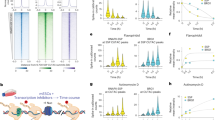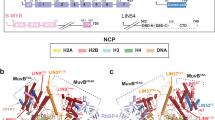Abstract
Specific nuclear factor-DNA complexes formed within the promoters and enhancers are essential for transcriptional regulation. For eukaryotic systems, however, some DNA motif(s) are capable of binding to a family of related factors, thus making it difficult to identify the factor actually binding on the chromatic DNA in vivo and modulating the local transcription processes. To resolve this matter, we have refined a chromatin immunoprecipitation assay. Using the assay, we could directly link the regulatory functions of two members of the AP1/NF-E2 transcription factor family and their stable binding in vivo within distinct chromatin regions. The study demonstrated the feasibility of a general scheme in the determination of the identity of specific factor(s), among a group of family members, bound at unique sequence(s) in living mammalian cells.
This is a preview of subscription content, access via your institution
Access options
Subscribe to this journal
Receive 50 print issues and online access
$259.00 per year
only $5.18 per issue
Buy this article
- Purchase on Springer Link
- Instant access to full article PDF
Prices may be subject to local taxes which are calculated during checkout



Similar content being viewed by others
References
Alberts AS, Geneste O and Treisman R. . 1998 Cell 92: 475–487.
Amrolia PJ, Ramamurthy L, Saluja D, Tanese N, Jane SM and Cunningham JM. . 1997 Proc. Natl. Acad. Sci. USA 94: 10051–10056.
Andrews NC, Erdjument-Bromage H, Davidson MB, Tempst P and Orkin SH. . 1993 Nature 362: 722–728.
Angel P and Karin M. . 1991 Biochem. Biophys. Acta 1072: 129–157.
Angel P, Harroti K, Smeal T and Karin M. . 1988a Cell 55: 875–885.
Angel P, Allegretto EA, Okino ST, Hattori K, Boyle WJ, Hunter T and Karin M. . 1988b Nature 332: 166–171.
Armstrong JA and Emerson BM. . 1996 Mol. Cell. Biol. 16: 5634–5644.
Blank V and Andrews NC. . 1997 Trends Biochem. Sci. 22: 437–441.
Botquin V, Hess H, Fuhrmann G, Anastassiadis C, Gross MK, Vriend G and Scholer HR. . 1998 Genes Dev. 12: 2073–2090.
Boulikas TA. . 1994 Crit. Rev. Eukaryot Gene Exp. 4: 117–321.
Cheng X, Reginato MJ, Andrews NC and Lazar MA. . 1997 Mol. Cell. Biol. 17: 1407–1416.
Devary Y, Gottlieb RA, Lou F and Karin M. . 1991 Mol. Cell. Biol. 11: 2804–2811.
Fleenor DE and Kaufman RE. . 1993 Blood 81: 2781–2790.
Gavva NR, Gavva R, Ermekova K, Sudol M and Shen CK. . 1997 J. Biol. Chem. 272: 24105–24108.
Gong QH, McDowell JC and Dean A. . 1996 Mol. Cell. Biol. 16: 6055–6064.
Gould AP, Brookman JJ, Strutt DI and White RA. . 1990 Nature 348: 308–312.
Herr I, van Dam H and Angel P. . 1994 Carcinogenesis 15: 1105–1113.
Huang BL, Fan-Chiang IR, Wen SC, Koo HC, Kao WY, Gavva NR and Shen CKJ. . 1998 Proc. Natl. Acad. Sci. USA 95: 14669–14674.
Ikuta T and Kan YW. . 1991 Proc. Natl. Acad. Sci. USA 88: 10188–10192.
Kotkow KJ and Orkin SH. . 1995 Mol. Cell. Biol. 15: 4640–4647.
Lee W, Mitchell P and Tjian R. . 1987 Cell 49: 741–752.
Lowrey CM, Bodine DM and Nienhuis AW. . 1992 Proc. Natl. Acad. Sci. USA 89: 1143–1147.
Lozzio CB and Lozzio BB. . 1975 Blood 45: 321–334.
Lu SJ, Rowan S, Bani MR and Ben-David Y. . 1994 Proc. Natl. Acad. Sci. USA 91: 8398–8402.
Martin F, van Deursen JM, Shivdasani RA, Jackson CW, Troutman AG and Ney PA. . 1998 Blood 91: 3459–3466.
Mignotte V, Eleowet JF, Raich N and Romeo PH. . 1989 Proc. Natl. Acad. Sci. USA 86: 6548–6552.
Moi P and Kan YW. . 1990 Proc. Natl. Acad. Sci. USA 87: 9000–9004.
Motohashi H, Shavit JA, Igarashi K, Yamamoto M and Engel JD. . 1997 Nucleic Acids Res. 25: 2953–2959.
Ney PA, Sorrentino BP, McDonagh KT and Nienhuis AW. . 1990 Genes Dev. 4: 993–1006.
Orlando V and Paro R. . 1993 Cell 75: 1187–1198.
Reddy PM and Shen CK. . 1991 Proc. Natl. Acad. Sci. USA 88: 8676–8680.
Rozek D and Pfeifer GP. . 1993 Mol. Cell. Biol. 13: 5490–5499.
Rundlett SE, Carmen AA, Suka N, Turner BM and Grunstein M. . 1998 Nature 392: 831–835.
Shivdasani RA and Orkin SH. . 1995 Proc. Natl. Acad. Sci. USA 92: 8690–8694.
Solomon MJ and Varshavsky A. . 1985 Proc. Natl. Acad. Sci. USA 82: 6470–6474.
Solomon MJ, Larsen PL and Varshavsky A. . 1988 Cell 53: 937–947.
Strauss EC and Orkin SH. . 1992 Proc. Natl. Acad. Sci. USA 89: 5809–5813.
Strauss EC, Andrews NC, Higgs DR and Orkin SH. . 1992 Mol. Cell. Biol. 12: 2135–2142.
Talbot D and Grosveld F. . 1991 EMBO J. 10: 1391–1398.
Walter J and Biggin MD. . 1996 Proc. Natl. Acad. Sci. USA 93: 2680–2685.
Wathelet MG, Lin CH, Parekh BS, Ronco LV, Howley PM and Maniatis T. . 1998 Mol. Cell 1: 507–518.
Zhang Q, Reddy PM, Yu CY, Bastiani C, Higgs D, Stamatoyannopoulos G, Papayannopoulou T and Shen CK. . 1993 Mol. Cell. Biol. 13: 2298–2308.
Acknowledgements
We thank Xin Chen for helpful discussions, and Rama Gavva for the technical help. This research was supported by US Public Health grant (NIH DK 29800), and by the Academia Sinica, National Science Council, and National Health Research Institute, Taipei, Taiwan, ROC.
Author information
Authors and Affiliations
Rights and permissions
About this article
Cite this article
Daftari, P., Gavva, N. & Shen, CK. Distinction between AP1 and NF-E2 factor-binding at specific chromatin regions in mammalian cells. Oncogene 18, 5482–5486 (1999). https://doi.org/10.1038/sj.onc.1202916
Received:
Revised:
Accepted:
Published:
Issue Date:
DOI: https://doi.org/10.1038/sj.onc.1202916
Keywords
This article is cited by
-
DNA sequence context as a marker of CpG methylation instability in normal and cancer tissues
Scientific Reports (2020)
-
Role of HDAC9-FoxO1 Axis in the Transcriptional Program Associated with Hepatic Gluconeogenesis
Scientific Reports (2017)
-
Regulation and function of the NFE2 transcription factor in hematopoietic and non-hematopoietic cells
Cellular and Molecular Life Sciences (2015)
-
Transcriptional control of erythropoiesis: emerging mechanisms and principles
Oncogene (2007)
-
Lineage-specific activators affect β-globin locus chromatin in multipotent hematopoietic progenitors
The EMBO Journal (2006)



